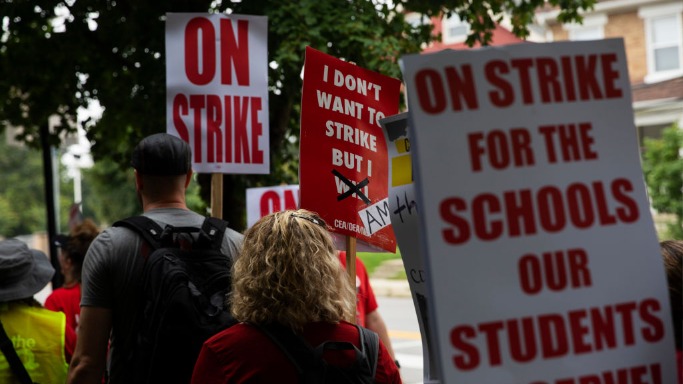To avoid becoming an impoverished, crime-ridden nation, our families and neighborhoods need high-performing teachers dedicated to improving literacy and math skills—now.
This requires teachers who will show up to work in person. Union-backed COVID-19 lockdown policies caused a drastic loss of learning—the largest decline in reading scores since 1990 and the first drop in mathematics scores ever recorded.
These test scores are a dire warning sign.
When kids lose a step at a young age, they and their communities face a dim future. Children who do not read proficiently by the end of third grade are four times more likely to drop out of high school. High-school dropouts are three and a half times more likely to commit crimes and land themselves in jail. The U.S. could lose $188 billion annually in GDP by 2040, due to lower productivity from lockdown-affected children.
But teachers’ unions—under current state policies that grant unions tremendous power—are continuing to lock children into miserable futures. This year, several major school districts have shut down due to teachers’ unions striking, demanding more money or more perks regardless of a teacher’s past performance.
A strike in my home state, Ohio, required students to start the year remotely. The Columbus union will head back to work, for now, with a 4 percent annual raise (not tied to performance) and guaranteed air conditioning. A strike in Seattle, a school district with average teacher salaries of $89,000, delayed the start of school entirely. The Seattle union demanded improved salaries and more benefits—including personal days and laptops for paraprofessionals. Teachers in Kent, Washington, where 4 in 10 teachers make over $100,000, also went on strike recently.
I, like most Americans, support compensating spectacular teachers and building an effective learning environment. I taught sixth graders and it was impossibly demanding and stressful. Most of my students were far behind grade level, meaning I had to create my own learning plan, worksheets, and tests for the class. I shelled out an enormous amount of money (that I didn’t have) to buy a classroom library, school supplies, and good-behavior rewards.
All for the grand salary of $30,000.
But I can only support unions if they help teachers help kids. And that isn’t the priority for the unions now making headlines.
The rise of teachers’ unions has correlated with lower incomes for Americans, particularly minorities, who are more likely to attend public schools. Ten years after states instituted duty-to-bargain laws, the annual earnings for men were reduced by nearly 4 percent and nearly 10 percent for black and Hispanic men.
In Columbus, only 33 percent of third-grade students passed language arts, and 26 percent passed math. And in Seattle, only 35 percent of low-income kids passed reading, and 24 percent passed math.
These poor outcomes should not be rewarded—they should wake us up. Our kids deserve drastically better.
States can save students from teachers’ unions in two obvious ways.
First, states can prohibit teachers’ unions from collectively bargaining and striking, giving school districts greater ability to fire poorly performing teachers and to keep and highly compensate excellent teachers. We might as well try. Texas prohibits teacher strikes and still provides its teachers with median salaries. More importantly, even though Texas has the second-highest population of non-English speakers, Texas still outranks 10 states and D.C. in fourth-grade reading scores.
Second, states can give parents the choice to flee strike-ridden, low-performing public schools. More than 20 states already offer private school choice programs, and 45 states allow charter schools. But until policies like education savings accounts are put in place to help parents control more of the tens of thousands of dollars the U.S. already spends per pupil annually, too much taxpayer money is directed to propping up failing schools rather than giving kids the tools they need.
As we fight teachers’ unions, we should also celebrate the future of the teaching profession, including in public schools. Public school teachers are, after all, funded by the public. Schools get richer—and teachers’ lives get better—when communities help all kids become hardworking, high-earning adults.

